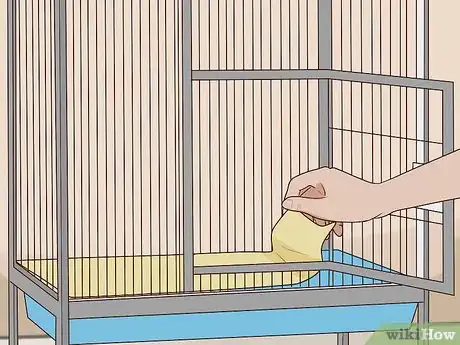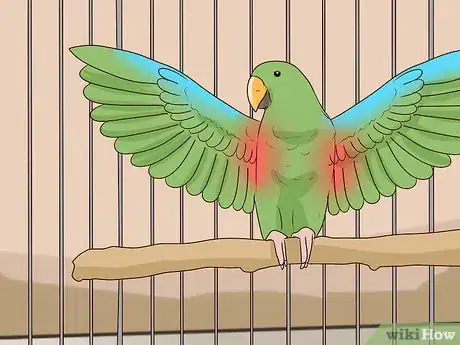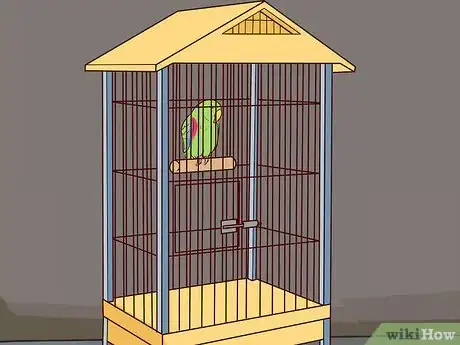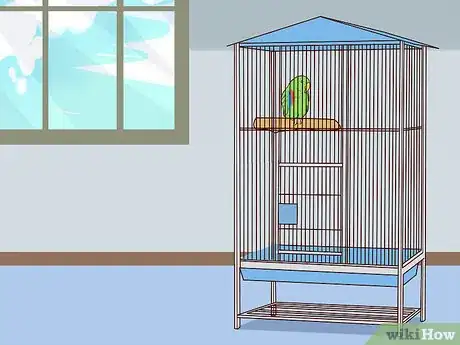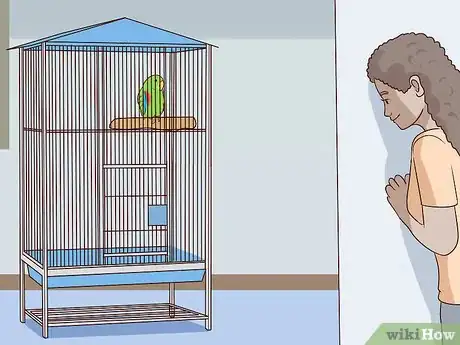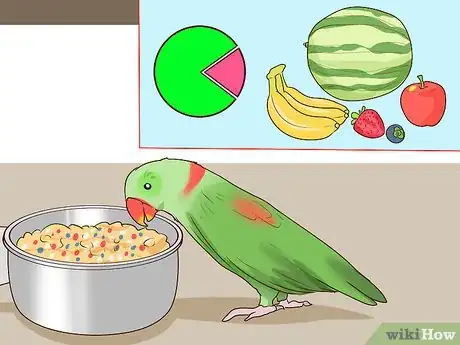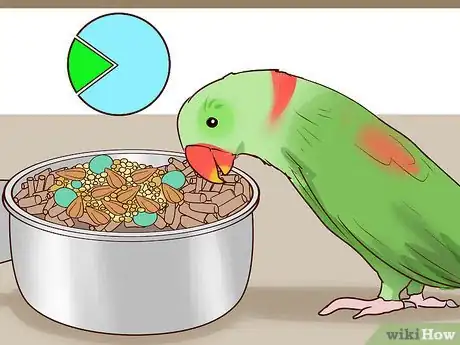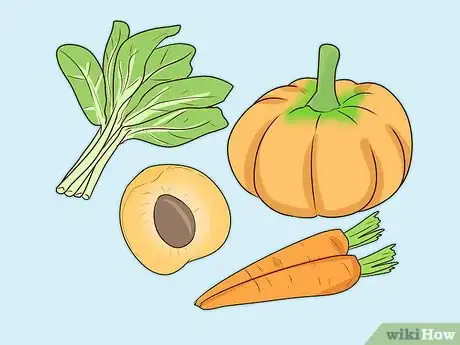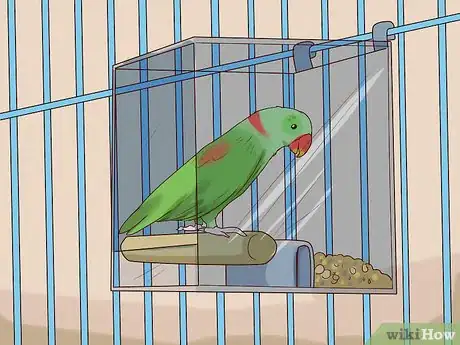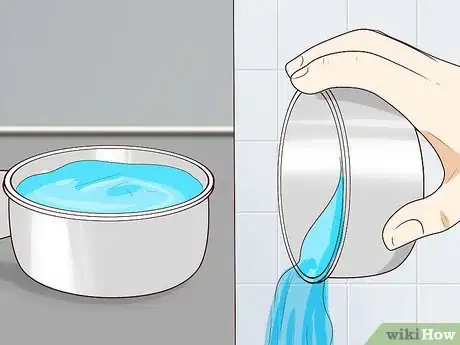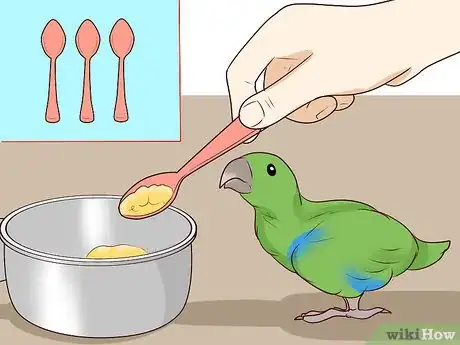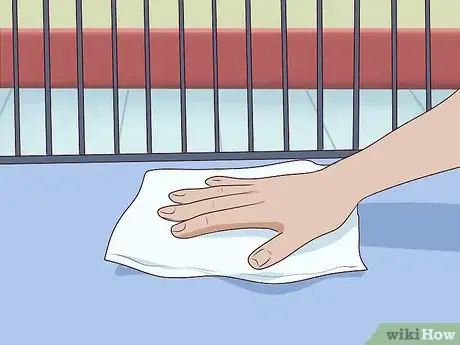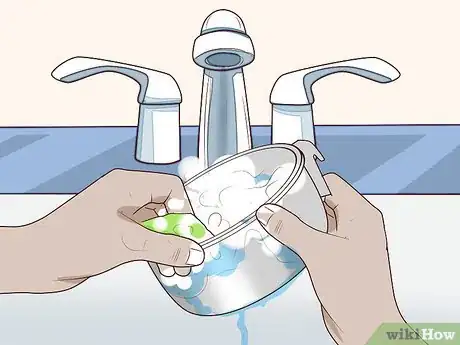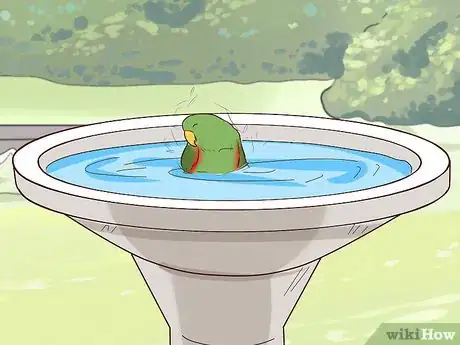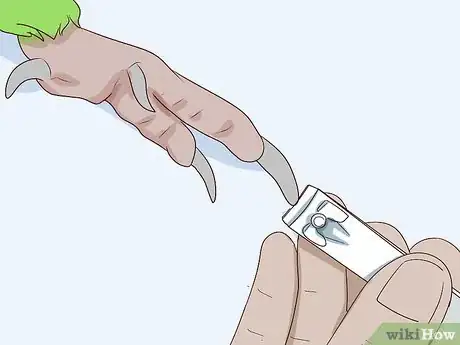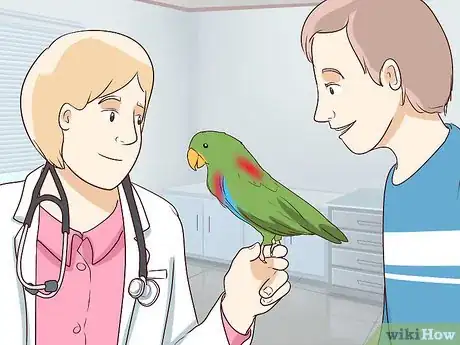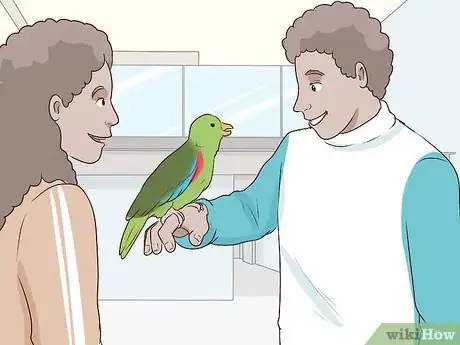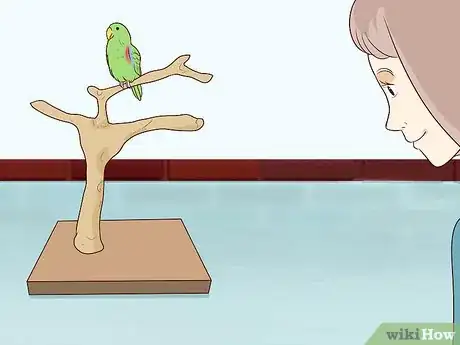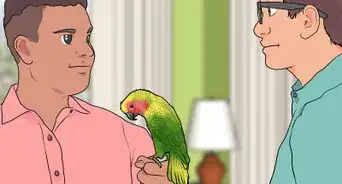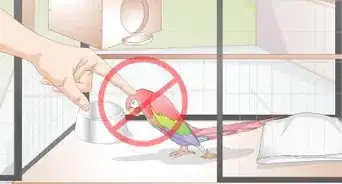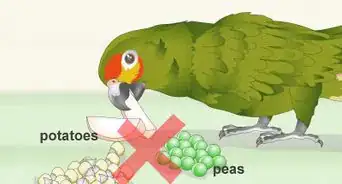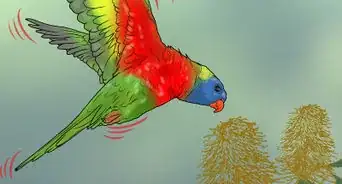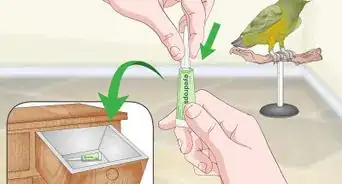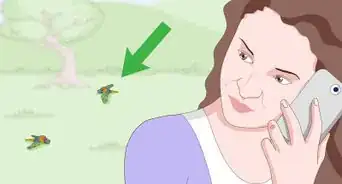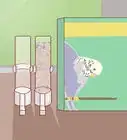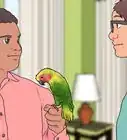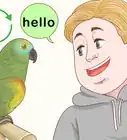This article was co-authored by Hayley Heartfield. Hayley Heartfield is a Bird Specialist and the Owner of About Birds, a Pet Bird Shop in Montgomery County, Texas. Hayley specializes in pet bird care, behavior, training, and breeding. Hayley studied Animal Science at Texas A&M. About Birds carries many species of birds and offers grooming and boarding services as well as bird care products.
wikiHow marks an article as reader-approved once it receives enough positive feedback. In this case, 100% of readers who voted found the article helpful, earning it our reader-approved status.
This article has been viewed 28,880 times.
Eclectus parrots are majestic parrots found originally in the Solomon Islands, Sumba, New Guinea, northeastern Australia, and the Maluku Islands. As pets, they are bright, bubbly, friendly, and intelligent companion animals. However, they require a very specific diet and husbandry to keep them both physically and emotionally healthy.
Steps
Setting up Its Home
-
1Purchase a cage larger than 1.5 by 1.5 by 1.5 metres (4.9 by 4.9 by 4.9 ft). Eclectus parrots love their space, so be sure to purchase a big cage! The cage should be large enough that the bird can stretch out wing tip to wing tip. In addition, it should have strong metal bars that cannot be bent by hand. You should also try getting a cage with a seed catch tray as parrots are very, very messy.
- The base should allow feces to fall through and be regularly cleaned.
- Make sure your cage has corners and isn't round.
-
2Add bedding to your parrot's cage. Newspaper, paper towels, butcher paper, and paper bags are the simplest and most effective bedding material. However, you can also create bedding from aspen shavings, wood pellets, and corncob in combination with a cage liner.
- Avoid using sand or shavings from cedar, redwood or treated pine.
Advertisement -
3Place a perch in the cage for your parrot to sit on.[1] Use perches more than 4 inches (10 cm) in diameter and at least as long as the bird's wingspan. The perches should be made of safe native plants—not 100 percent plywood.
- Make sure you parrot's feet can encircle about ¾ of the perch.
-
4Add bowls and accessories. Every cage needs 1 food bowl and 2 water bowls—1 for bathing and 1 for drinking. If you have multiple birds, there should be at least as many bowls as birds. And if you want to add some décor, make sure it's not made from anything that your parrot can easily swallow.
- Attach bowls to the sides of the cage instead of placing them on the floor, which is where they feel most vulnerable.
-
5Buy a night cage for sleeping to encourage a healthy schedule. Some owners purchase night cages to simulate the bird going to its resting place, as it would in the wild. In general, Eclectus parrots require about 10 hours of sleep a night. If you can't provide this to them in a normal cage, invest in a night cage. Purchase a cage that gives your parrot enough room to move around, stretch its wings, and prune. Place it next to its daytime cage or somewhere that's quiet at night.
- Provide some toys and water in the night cage.
- Keep noise around the night cage to a minimum.
- If you don't buy a night cage, make sure to stick to a regular sleep cycle.
- You can place a cover, such as a blanket, over the cage. However, a room with curtains drawn is a better way to prevent excessive lighting that stimulates pathogen growth.
-
6Place the cage in a high-traffic area to give your parrot ample social interaction. Living rooms and dining rooms are typically the best choices. Just make sure that the cage isn't in any direct sunlight.[2]
- Keep your parrot away from loud ventilation or air conditioning units.
-
7Leave your parrot alone for the first 3 days. A new environment is stressful for your parrot. Always give it a few days with minimal interaction to allow it to adjust to its new home. You can still try interacting with it, but if you notice it getting stressed or agitated give it some space.[3]
- Be sure to keep other pets away from the cage when your parrot is adjusting to its new home.
Providing the Right Diet
-
1Provide your parrot a low-fat, high-fiber diet of 80 percent soft foods. The Eclectus parrot diet is one of the most challenging parts of owning them. They require large amounts of fresh produce, which can be very costly. The majority of their diet should be soft, fresh food like fruits and vegetables. They typically enjoy bananas, mango, corn-on-the-cob, apple, berries, passion fruit, watermelon, and cantaloupe.[4]
- Make sure fresh, cooked, and soaked foods are removed daily to prevent contamination.
-
2Use seed mix, pellets, and some nuts for the remaining 20 percent. Stick to sprouted or germinated seeds, as they're easier for parrots to digest. Purchase seed mixes with dried fruits, greens, veggies, and superfoods, and avoid colored pellets.[5]
- Avoid providing more seeds than pellets unless your bird has recently been weaned.
-
3Focus on foods with Vitamin A to prevent nutrient deficiency. It's common for Eclectus parrots to be deficient in Vitamin A. Focus on adding dark, leafy vegetables and anything orange-colored—carrots, pumpkins, carrots, sweet potatoes, apricots, and cantaloupes—with other fruits and vegetables. Just be sure to mash them up as much as you can.[6]
- Choose natural vitamin A over supplements—the latter is often not absorbable and can lead to overdose.
- Dark, green leafy vegetables are also great sources of vitamin A. For example, kale, spinach, zucchini, and bok choy are excellent.
-
4Feed your parrot appropriately. When it comes to feeding Eclectus parrots, always use something durable and easily cleaned, such as Tupperware. A perspex box is a great new option on the market that allows the bird to sit inside and eat its food without making a mess.[7]
- Use stainless bowls for a simple option that's easy to clean.
- Make sure the bowls remain in their holders. If you don't, your Eclectus parrot can easily remove them.
- You can also hide food in cardboard boxes, toilet paper, or paper. This is great for enrichment as well as encouraging foraging behavior. Just be sure to check each product for harmful chemicals.
-
5Change and refill your parrot's water daily. Whether you're using bowls or water bottles, always change your parrot's water daily to prevent the buildup of harmful pathogens. Try to change the water at the same time daily, such as in the morning before heading off to work.[8]
- If your local water doesn't go through a filtration facility, purchase filtered water, bottled water, or de-ionized water.
-
6Feed your parrot around 1-3 tablespoons (16-41 grams) of food daily. For a small bird, feed it 1/2 teaspoon (2.38 grams) of fruit, 1/2 tablespoon (7.15 grams) of vegetables, and 1/2 tablespoon (7.15 grams) of protein daily. If you have a larger parrot, feed it 1 teaspoon (4.77 grams) of fruit, 1 tablespoon (14.3 grams) of vegetables, and 1.5 tablespoons (21.45 grams) of protein.[9]
- Don't feed your parrot food larger than the size of its head.
- Eclectus parrots range from 17 to 20 inches (43 to 51 cm) from beak to tail. Parrots on the low end of the spectrum or less are small, and anything on the higher end or higher are large.
Cleaning and Grooming
-
1Clean your parrot's cages daily. Use a microfiber cloth and cleaning solution that is safe for pets. Remove the floor covering and wipe down the entire surface of the floor.[10] Parrots love to throw food to the floor of the cage, which can cause feces buildup and increase the risk of pathogens such as intestinal worms. Afterward, clean the surface of the cage and the water bowls.
- Line the floor of the cage with paper, such as newspaper or plain paper, for easier cleaning. Avoid things like artificial turf or other artificial substances.
- Paper-based kitty litter may also be used, but avoid non-paper alternatives, as these can cause impaction.
- Avoid cleaning chemicals—they can kill parrots. Always purchase safe bird alternatives from pet stores.
-
2Clean food bowls that hold fresh fruit and vegetables twice daily. Fresh produce attracts flies and can lead to microbe growth. Apply a pet-safe cleaning solution to the food bowls and wipe them down with a damp microfiber cloth.
- If you find your bowls getting dirty over time, swap them out for new ones.
-
3Bathe your parrot every 1 to 2 days. Eclectus parrots should be allowed to bathe daily—or at least every second day—in their bathing bowl. They also love to be bathed with a handheld spray bottle on the mist setting. Just make sure to only bathe them during daytime hours.
- In the summer, completely soak your parrot in water about 2 times a week. Make sure that all of their feathers as well as their skin is exposed to water.
-
4Clip your Eclectus parrot's claws before they get sharp. Your parrot's nails can get very sharp and accidentally hurt you. If you don't have experience cutting bird nails, hire someone who is trained—their nails contain blood vessels that can lead to excessive bleeding when cut.
- Don't clip your Eclectus parrot's wings. Instead, invest in other alternatives, such as harnesses. You can also prevent it from flying around the house unattended or teach it basic recall before allowing it to fly around.
-
5Hire an avian veterinarian for visits at least once a year. Always make sure your birds are examined professionally every year to keep their health in peak shape and avoid any diseases. Choose a veterinarian that has experience with Eclectus parrots.
- Be sure to hire an avian veterinarian right after you get your Eclectus parrot for a physical examination, as well as wellness and diagnostic tests.
Keeping Your Parrot Busy
-
1Provide enrichment and toys for your parrot. The cage should be filled with activities for the parrot to keep it busy while you're not with it or it's locked in the cage.[11] Small boxes, vine balls, grass mats, soft plastics, leather strips, and wooden beads are great choices. Toys specifically made for parrots are your best bet, but you can also make some on your own. Just make sure they don't have anything that can be swallowed or that the parrot could become caught in.
- Avoid rope toys, as the fibers can be ingested. This can cause crop impaction and kill your parrot. Stick to native string ropes like hemp.
- Inspect metal toys for any peeling or rusting to prevent heavy metal poisoning.
- Check plastic toys to ensure they aren't brittle and don't have broken edges.
-
2Give your parrot lots of attention and affection to prevent stress. Eclectus parrots love interaction! Try and be social with them and encourage your family and friends to interact with them. They are very sensitive and can develop stress when they feel neglected. Don't get an Eclectus parrot if you're not prepared to spend a lot of time with it.[12]
- Keep watch of males, as they are less independent and more susceptible to stress.
- Anything from watching TV with your parrot to playing games is healthy.
- Build a trusting relationship by handling your parrot carefully and with respect
-
3Give your parrot at least 4 hours outside of its cage daily. Eclectus parrots need a large portion of your time devoted to them to stimulate them. Let them out of their cage daily and set up a play stand with a perch, treats, and activities. This also lets them stretch, fly around, and explore outside the confines of their cage.
- Interaction with your parrot is a must!
- Training, such as clicker training, is excellent for helping a new parrot settle in and learn acceptable behavior.
Community Q&A
-
QuestionI know all avian vets are different, but what is he average cost of a vet visit for all necessary tests and exams and an overall checkup?
 Community AnswerLike you said, every vet is different, but from all that I've read, in total it is probably about $250 to $300.
Community AnswerLike you said, every vet is different, but from all that I've read, in total it is probably about $250 to $300. -
QuestionMy eclectus is 13 years old but he wont chew anything and his beak gets very long. How can I fix this problem?
 Community AnswerTry rotating his toys every week and getting cuttle bones to feed him and trim his beak.
Community AnswerTry rotating his toys every week and getting cuttle bones to feed him and trim his beak. -
QuestionMy parrot is removing feathers; why is that? I have a female Eclectus parrot.
 Community AnswerIt may be due to calcium and iron deficiencies. Try giving it spinach and vitamins twice a week. That will do the job for sure.
Community AnswerIt may be due to calcium and iron deficiencies. Try giving it spinach and vitamins twice a week. That will do the job for sure.
Warnings
- Never leave the cage outdoors in regions where predators such as snakes, raccoons, or feral cats are common.⧼thumbs_response⧽
- Do not place the cage in sight of other birds or outdoors predators will be able to hurt them.⧼thumbs_response⧽
- Avoid giving your parrot vitamin and mineral supplements.⧼thumbs_response⧽
- Do not allow your parrot to fly outdoors, be outdoors unrestrained, or leave them unattended outdoors.⧼thumbs_response⧽
- Eclectus parrots can cause damage if left unattended or sometimes even if you are watching.⧼thumbs_response⧽
- Check for mites regularly and treat them if needed.⧼thumbs_response⧽
- Always provide fresh water daily. In addition, clean and refill the water bowl 2 to 3 times daily.⧼thumbs_response⧽
- Remember that Eclectus parrots live for 50 years or more. They are a huge commitment!⧼thumbs_response⧽
- Do not allow your parrot to eat out of your mouth.⧼thumbs_response⧽
- Do not give your parrots alcohol, chocolate, avocado, apple seeds, grit, high sugar or salty foods, carrot tops, too much spinach or celery, undercooked legumes, caffeine, hard fruit seeds, or rhubarb.⧼thumbs_response⧽
- Worm your parrot 3 times a month or as per veterinarian recommendations.⧼thumbs_response⧽
- Eclectus parrots will be noisy, they will bite, and sometimes they may cause you to bleed. However, returning the bird to its cage or ignoring is the best reaction, as negative reactions (or sometimes any reaction at all) will result in the bird repeating or exaggerating the behavior.⧼thumbs_response⧽
References
- ↑ Hayley Heartfield. Bird Specialist. Expert Interview. 23 June 2021.
- ↑ https://birdeden.com/eclectus-parrots-as-pets
- ↑ https://birdsville.net.au/pet-bird-advice-and-training/care-sheets/eclectus-care-sheet/
- ↑ http://www.beautyofbirds.com/eclectusfood.htm
- ↑ http://www.beautyofbirds.com/eclectusfood.htm
- ↑ http://www.beautyofbirds.com/eclectusfood.htm
- ↑ http://www.beautyofbirds.com/eclectusfood.htm
- ↑ http://www.beautyofbirds.com/eclectusfood.htm
- ↑ https://www.chewy.com/petcentral/what-do-parrots-eat
- ↑ Hayley Heartfield. Bird Specialist. Expert Interview. 23 June 2021.
- ↑ Hayley Heartfield. Bird Specialist. Expert Interview. 23 June 2021.
- ↑ https://birdeden.com/eclectus-parrots-as-pets
About This Article
To care for an Eclectus parrot, buy a spacious cage and place it in a high-traffic area of your home, since these birds are very social. Feed the parrot a low-fat, high-fiber diet that is 80% soft, fresh produce foods. The other 20% of their diet should come from seeds, pellets, and nuts. Give the parrot 1-3 tablespoons of food per day, depending on its size, and be sure to clean and refill its water dish daily. For tips on grooming your parrot, read on!

